Introduction to Btrfs
The file system seems to be a relatively stable part of the kernel. For many years, people have been using ext2/3. The ext file system has become the de facto Linux standard file system with its excellent stability. In recent years, ext2/3 has exposed some scalability problems, and it has spawned ext4. The ext4 dev version was integrated in the Linux 2.6.19 kernel released in 2008. 2.6.28 When the kernel was released, ext4 ended the development version and began accepting users. It seems that ext will become synonymous with the Linux file system. However, when you read a lot of articles about ext4, you will find that btrfs is invariably mentioned, and that ext4 will be a transitional file system. Theodore Tso, the author of ext4, also praised btrfs and believes btrfs will be the next generation Linux standard file system. Companies such as Oracle, IBM, and Intel also showed great interest in btrfs, investing money and manpower. Why are btrfs so attractive? This is the question that this article wants to discuss first.
Kevin Bowling [1] has an article describing various file systems. In his view, file systems such as ext2/3 are "classical." The new era of file systems was created in 2005 by Sun's ZFS. ZFS stands for "last word in file system", meaning that there is no need to develop any other file system. ZFS does bring a lot of new ideas and is an epoch-making work for the file system.
If you compare the characteristics of btrfs, you will find that btrfs is very similar to ZFS. Maybe we can think of btrfs as the response of the Linux community to ZFS. From then on, finally there is a file system that can be comparable to ZFS in Linux.
Btrfs features
You can see the btrfs feature list on the btrfs home page [2]. I made my own claim and divided the list into four major parts.
The first is scalability-related features. The most important design goal for btrfs is to address the scalability requirements for large file systems. Features such as Extent, B-Tree, and dynamic inode creation ensure that btrfs still perform well on large machines and its overall performance does not decrease as the system capacity increases.
The second is data integrity-related features. The system faces unpredictable hardware failures. Btrfs uses COW transaction technology to ensure file system consistency. Btrfs also supports checksums to avoid the appearance of silent corrupt. Traditional file systems cannot do this.
The third is related to the characteristics of multi-device management. Btrfs supports the creation of snapshots and clones. Btrfs can also easily manage multiple physical devices, making traditional volume management software redundant.
Finally, there are other features that are difficult to classify. These features are relatively advanced technologies that can significantly improve the file system's time/space performance, including delayed allocation, storage optimization of small files, and directory indexes.
Extensibility related features
B-Tree
All metadata in the btrfs file system is managed by BTree. The main advantage of using BTree is that the lookup, insert, and delete operations are very efficient. It can be said that BTree is the core of btrfs.
Blindly boasting that BTree is very good and efficient may not be convincing, but if you spend a little time looking at the implementation of metadata management in ext2/3, you can reflect the advantages of BTree.
One issue that hinders ext2/3 scalability is the way its catalog is organized. A directory is a special file whose content is a linear table in ext2/3. As shown in Figure 1-1 [6]:
Figure 1. ext2 directory [6]
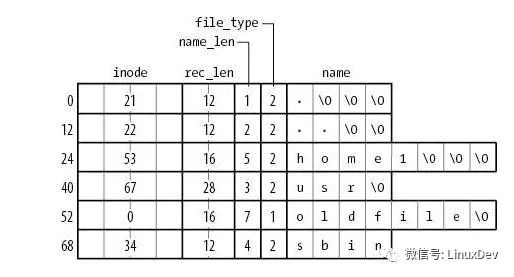
Figure 1 shows the contents of an ext2 directory file containing four files. They are "home1", "usr", "oldfile" and "sbin". If you need to find the directory sbin in the directory, ext2 will traverse the first three until you find the sbin string.
This structure is relatively intuitive in the case of a limited number of files, but as the number of files in the directory increases, the time for finding files will increase linearly. In 2003, ext3 designers developed a directory indexing technique that solved this problem. The data structure used by the catalog index is BTree. If the number of files in the same directory exceeds 2K, the i_data field in the inode points to a special block. The directory index BTree is stored in this block. BTree's search efficiency is higher than the linear table,
But designing two data structures for the same metadata is always less elegant. There are many other metadata in the file system. Managing with a unified BTree is a very simple and elegant design.
All Btrfs internal metadata is managed by BTree and has good scalability. Different metadata within btrfs are managed by different trees. In superblock, there are pointers to the roots of these BTrees. as shown in picture 2:
Figure 2. btrfs btree
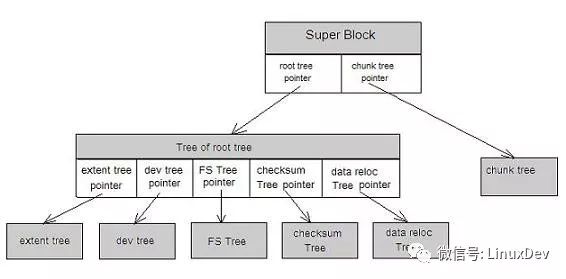
FS Tree manages file-related metadata, such as inode, dir, etc. Chunk tree manages devices. Each disk device has an item in the Chunk Tree. The Extent Tree manages disk space allocation. Each time btrfs allocates a disk space, it allocates it. Disk space information is inserted into the Extent tree. Querying the Extent Tree will get free disk space information; Tree of tree root holds many BTree root nodes. For example, every time a user creates a snapshot, btrfs creates an FS Tree. To manage all the trees, btrfs uses the Tree of tree root to hold the root nodes of all trees; the checksum Tree holds the checksum of the data blocks.
Extent-based file storage
Modern file systems use extent instead of block to manage disks. Extent is a contiguous block. An extent is defined by the starting block plus the length.
Extent can effectively reduce the metadata overhead. To further understand this issue, let's take a look at the negative examples in ext2.
Ext2/3 takes the block as the basic unit and divides the disk into multiple blocks. In order to manage disk space, the file system needs to know which blocks are free. Ext uses bitmap for this purpose. Each bit in the Bitmap corresponds to a block on the disk. When the corresponding block is allocated, the corresponding bit in the bitmap is set to 1. This is a classic and very clear design, but unfortunately when the disk capacity becomes larger, the space occupied by the bitmap itself will also become larger. This leads to scalability problems. With the increase in storage device capacity, the space occupied by the bitmap metadata also increases. And people hope that regardless of the increase in disk capacity, metadata should not increase linearly with it. This design is scalable.
The following figure compares the difference between block and extent:
Figure 3. btrfs with extents and ext2/3 with bitmaps

In ext2/3, 10 blocks require 10 bits; in btrfs only one metadata is needed. For large files, extent shows more excellent management performance.
Extent is the smallest unit of btrfs management disk space, managed by the extent tree. Btrfs allocates either data or metadata to query extent tree for free space information.
Dynamic inode allocation
In order to understand the dynamic inode allocation, it still needs ext2/3. The following table lists the limitations of the ext2 file system:
Table 1. ext2 limits

Figure 4 shows the disk layout of ext2:
Figure 4. ext2 layout
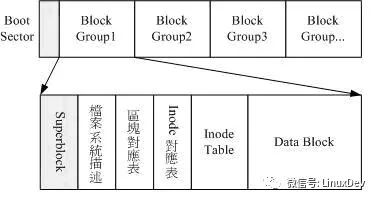
The inode area is fixedly allocated in ext2 and has a fixed size. For example, in a 100G partition, only 131072 inodes can be stored in the inode table area. This means that it is impossible to create more than 131072 files because each file There must be a unique inode.
To solve this problem, inodes must be dynamically allocated. Each inode is just a node in the BTree. The user can insert any new inode without restriction, and its physical storage location is dynamically allocated. So btrfs does not limit the number of files.
Optimized support for SSDs
SSD is short for Solid State Disk. In the past few decades, the development of devices such as CPU/RAM has always followed Moore's Law, but the hard disk HDD's read and write speed has never been a leap. Disk IO is always the bottleneck of system performance.
The SSD adopts flash memory technology. There are no mechanical devices such as disk heads inside, and the read/write speed is greatly improved. Flash memory has some features different from HDD. Flash must perform an erase operation before writing data. Secondly, flash has a certain limit on the number of erase operations. Under the current state of technology, it is possible to perform up to approximately one million erase operations on the same data unit. In order to prolong the life of the flash, write operations should be averaged over the entire flash.
The SSD implements wear leveling and other distributed write operations in hardware microcode, so the system does not need to use special MTD drivers and FTL layers. Although SSD has made many efforts at the hardware level, it is still limited. Optimizing the file system for the characteristics of the SSD can not only improve the service life of the SSD, but also improve the read/write performance. Btrfs is one of the few file systems optimized specifically for SSDs. The btrfs user can use the mount parameter to turn on special optimization of the SSD.
Btrfs' COW technology fundamentally avoids repeated writing to the same physical unit. If the user has turned on the SSD optimization option, btrfs will optimize on the underlying block space allocation policy: aggregate multiple disk space allocation requests into a continuous block of size 2M. Bulk-addressed IOs allow microcode optimized for SSDs to be read and write optimized for improved IO performance.
Data consistency-related features
COW affairs
To understand COW transactions, you must first understand the terms COW and transaction.
What is COW?
The so-called COW, that is, each time you write disk data, update data is written to a new block, when the new data is written successfully, and then update the relevant data structure points to the new block.
What is a business?
COW can only guarantee the atomicity of a single data update. However, many operations in the file system need to update multiple different metadata. For example, to create a file, you need to modify the following metadata:
Modify extent tree, allocate a piece of disk space
Create a new inode and insert it into the FS Tree
Add a directory entry to the FS Tree
If any one step fails, the file cannot be created successfully, so it can be defined as a transaction.
The following shows a COW transaction.
A is the root node of the FS Tree. The information of the new inode will be inserted into node C. First, btrfs inserts the inode into a newly allocated block C' and modifies the upper node B to point to the new block C'; modifying B will also trigger COW, and so on, triggering a chain reaction until the topmost Root A. When the entire process is over, the new node A' becomes the root of the FS Tree. But at this point the transaction did not end and superblock still points to A.
Figure 5. COW transaction 1
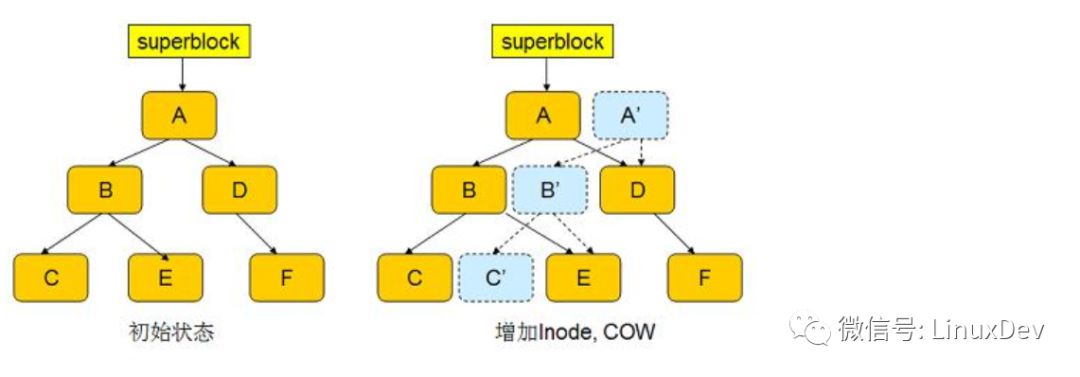
Next, modify the directory entry (E node) and similarly initiate this process to generate a new root node A''.
Figure 6. COW transaction 2
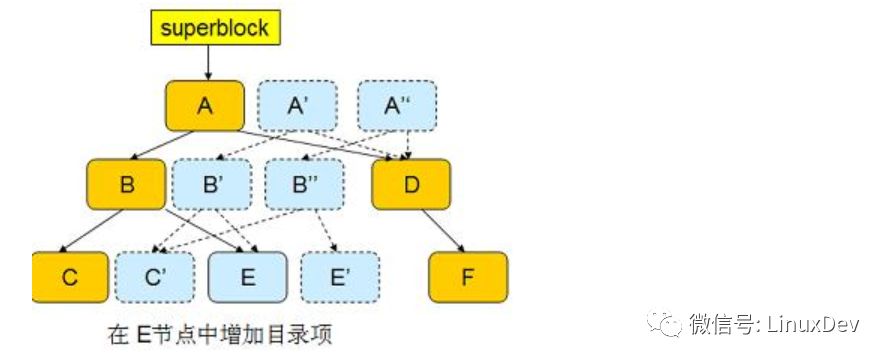
At this point, both the inode and the directory entry have been written to disk, and the transaction is considered to have ended. Btrfs modifies the superblock to point to A ', as shown below:
Figure 7. COW transaction 3
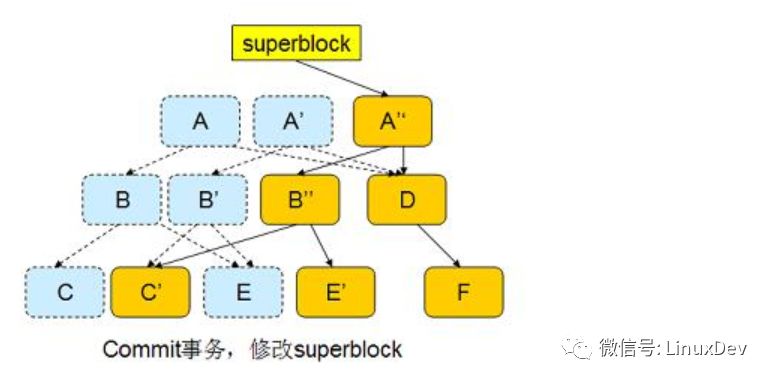
COW transactions ensure the consistency of the file system and do not need to perform fsck after the system Reboot. Because the superblock either points to the new A' or points to A, whichever is consistent data.
Checksum
Checksum technology ensures data reliability and avoids silent corruption. Due to hardware reasons, the data read from the disk can go wrong. For example, the data stored in block A is 0x55, but the data read out is 0x54, because the read operation does not report an error, so this error cannot be detected by the upper layer software.
The solution to this problem is to save the checksum of the data and check the checksum after reading the data. If it does not meet, it knows that the data has gone wrong.
Ext2/3 does not have a checksum and is completely trusting the disk. Unfortunately, disk errors are always present, not only on inexpensive IDE hard drives, but also on expensive RAID with a silent corruption issue. And with the development of storage networks, even if the data is read correctly from the disk, it is difficult to ensure that it can safely traverse network devices.
Btrfs reads its data and reads its corresponding checksum. If the data and the checksum ultimately read from the disk are not the same, btrfs will first attempt to read the mirrored copy of the data. If the data does not have a mirrored copy, btrfs will return an error. Btrfs calculates the checksum of the data before writing to disk data. Then write checksum and data to disk at the same time.
Btrfs uses a separate checksum tree to manage the checksums of the data blocks, separating the checksum from the data blocks protected by the checksum, thus providing more stringent protection. If you add a field to the checksum in the header of each data block, then the data block becomes a structure that protects itself. There is an error in this structure that cannot be detected. For example, if the file system intends to read block A from disk, block B is returned. Since checksum is inside the block, checksum is still correct. Btrfs uses the checksum tree to save the checksum of the data block, avoiding the above problems.
Btrfs uses the crc32 algorithm to calculate the checksum and will support other types of checksum algorithms in future development. To improve efficiency, btrfs writes data and checksums in parallel using different kernel threads.
Multi-device management related features
Every Unix administrator has faced the task of allocating disk space for users and various applications. In most cases, one cannot accurately estimate in advance how much disk space a user or application will need in the future. The situation that the disk space is exhausted often happens, at this moment people have to try to increase the file system space. Traditional ext2/3 can not meet this demand.
Many volume management software is designed to meet the needs of users for multi-device management, such as LVM. Btrfs integrates the capabilities of volume management software to simplify user commands on the one hand and improve efficiency on the other.
Multi-device management
Btrfs supports dynamically adding devices. After users add new disks to the system, they can use the btrfs command to add the device to the file system.
In order to make flexible use of device space, Btrfs divides disk space into multiple chunks. Each chunk can use a different disk space allocation strategy. For example, some chunks only store metadata, and some chunks only store data. Some chunks can be configured as mirrors, while others can be configured as stripe. This provides users with very flexible configuration possibilities.
Subvolume
Subvolume is a very elegant concept. That is to configure a part of the file system as a complete sub-file system, called subvolume.
With subvolume, a large file system can be divided into multiple sub-file systems. These sub-file systems share the underlying device space and are allocated from the underlying device when disk space is needed, just as an application calls malloc() to allocate memory. It can be called a storage pool. This model has many advantages. For example, it can fully utilize the bandwidth of the disk, and can simplify the management of disk space.
The so-called full use of the bandwidth of the disk means that the file system can read and write multiple underlying disks in parallel. This is because each file system can access all the disks. Traditional file systems cannot share the underlying disk devices, whether physical or logical, and therefore cannot read and write in parallel.
Simplified management is relative to volume management software such as LVM. With the storage pool model, the size of each file system can be automatically adjusted. With LVM, if there is not enough space for a file system, the file system cannot automatically use free space on other disk devices. Instead, it must be manually adjusted using LVM management commands.
Subvolume can be mounted as a root to any mount point. Subvolume is a very interesting feature, there are many applications.
If the administrator only wants some users to access a part of the file system, for example, they want the user to only have access to everything under /var/test/ and not to the other contents under /var/. Then you can make /var/test a subvolume. /var/test This subvolume is a complete file system that can be mounted using the mount command. For example, if you mount it to the /test directory and give the user access to /test, then the user can only access the contents of /var/test.
Snapshots and clones
Snapshots are full backups of the file system at some point in time. After a snapshot is taken, changes to the file system do not affect the contents of the snapshot. This is a very useful technique.
For example, database backup. If at the time T1, the administrator decides to back up the database, he must first stop the database. Backing up files is a time-consuming operation. If an application changes the contents of the database during the backup process, a consistent backup will not be available. Therefore, the database service must be stopped during the backup process, which cannot be allowed for some key applications.
With snapshots, administrators can stop the database at time T1 and take a snapshot of the system. This process generally takes only a few seconds, and you can immediately resume the database service. At any time thereafter, the administrator can perform backup operations on the contents of the snapshot. At this time, the user's changes to the database will not affect the contents of the snapshot. When the backup is complete, the administrator can delete the snapshot and free up disk space.
Snapshots are generally read-only, and when the system supports writable snapshots, this type of writable snapshot is called cloning. Cloning technology also has many applications. For example, you can install basic software in a system and then make different clones for different users. Each user uses his own clone without affecting other users' disk space. It is very similar to a virtual machine.
Btrfs supports snapshot and clone. This feature greatly increases the use of btrfs, users do not need to buy and install expensive and use complex volume management software. The following is a brief introduction to the basic principles of btrfs implementation of snapshots.
As mentioned earlier, Btrfs adopts COW transaction technology. From Figure 1-10, we can see that after the COW transaction ends, if the original nodes A, C, and E are not deleted, then A, C, E, D, F are still intact. The file system before the business started. This is the basic principle of the snapshot implementation.
Btrfs uses the reference count to determine whether to delete the old node after the transaction commit. For each node, btrfs maintains a reference count. When the node is referenced by another node, the count is increased by one. When the node is no longer referenced by another node, the count is decreased by one. When the reference count returns to zero, the node is deleted. For an ordinary Tree Root, the reference count is incremented on creation because Superblock references this Root block. Obviously, all other nodes in this tree in the initial case have a reference count of one. When the COW transaction commits, the superblock is modified to point to the new Root A''. The reference count of the original Root block A is decremented by one and becomes zero, so the A node is deleted. The deletion of node A will cause the reference count of its descendant node to decrease by one. In figure 1-10, the reference count of node C is also changed to 0, and thus it is deleted. D. When the E node is at COW, the counter is incremented because it is referenced by A''. Therefore, the counter is not reset to zero at this time and is not deleted.
When creating a snapshot, btrfs copies the Root A node to sA and sets the sA's reference count to 2 . When the transaction commits, the sA node's reference count will not be zeroed and will not be deleted, so the user can continue to access the snapshot's files through Root sA.
Figure 8. Snapshot
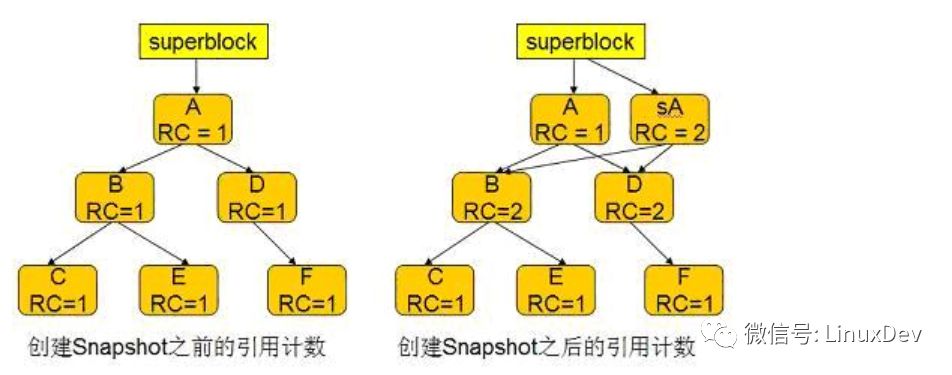
Software RAID
RAID technology has many attractive features. For example, users can combine multiple inexpensive IDE disks into a RAID0 array to become a large-capacity disk. RAID1 and higher-level RAID configurations also provide data redundancy protection. This makes the data stored on the disk more secure.
Btrfs supports software RAID well. RAID types include RAID0, RAID1, and RAID10.
Btrfs performs RAID1 protection on metadata by default. As mentioned earlier, btrfs divides device space into chunks, and some chunks are configured as metadata, that is, only metadata is stored. For such chunks, btrfs splits the chunk into two strips. When writing metadata, it writes two strips at the same time, thus protecting the metadata.
Other features
Other features listed on the Btrfs home page are not easily categorized. These features are more advanced in modern file systems and can increase the time or space efficiency of file systems.
Delay allocation
Delayed allocation technology can reduce disk fragmentation. In the Linux kernel, many operations are delayed for efficiency.
In a file system, frequent allocation and release of small chunks can cause fragmentation. Delayed allocation is a technique that saves data in memory when users need disk space. And the disk allocation needs are sent to the disk space allocator, and the disk space allocator does not immediately allocate real disk space. Just record this request and return.
Disk space allocation requests can be very frequent, so during a period of delayed allocation, the disk allocator can receive many allocation requests, some requests may be merged, and some requests may even be cancelled during this delay. With such "wait", it is often possible to reduce unnecessary allocations, and it is also possible to combine multiple small allocation requests into one large request, thereby improving IO efficiency.
Inline file
There are often a large number of small files in the system, such as a few hundred bytes or less. If you allocate a separate block of data, it will cause internal fragmentation and waste disk space. Btrfs saves the contents of small files in the metadata, no longer allocates disk blocks for file data. Improved internal fragmentation and increased file access efficiency.
Figure 9. inline file
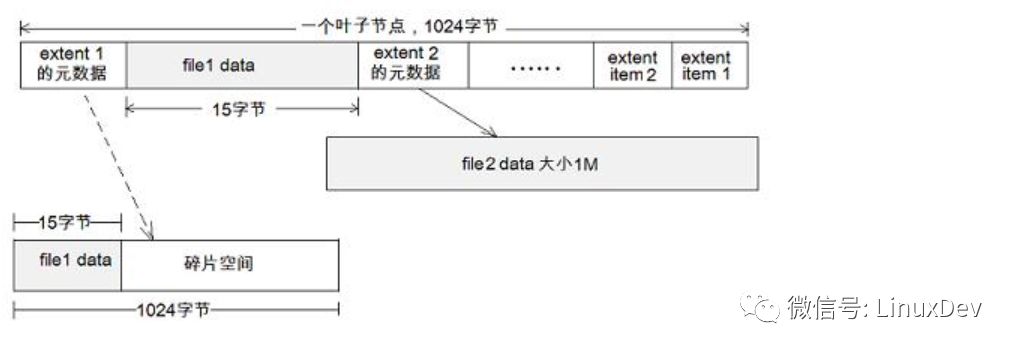
The figure above shows a BTree's leaf node. There are two extent data item metadata in the leaves, which are used to represent the disk space used by files file1 and file2.
Assume that file1 is only 15 bytes in size; file2 is 1M in size. As shown in the figure, file2 uses the ordinary extent representation: extent2 metadata points to an extent with a size of 1M, and its contents are the contents of the file2 file.
For file1, btrfs embeds its contents in the metadata extent1. If you do not use inline file technology. As the dotted line shows, extent1 points to a minimum extent, a block, but file1 has 15 bytes and the rest of the space becomes fragmented.
Using inline technology, when reading file1, it only needs to read the metadata block without first reading the metadata of extent1 and then reading the block that actually holds the contents of the file, thereby reducing disk IO.
Thanks to the inline file technology, btrfs handles small files very efficiently and avoids disk fragmentation issues.
Directory index Directory index
When a large number of files are in one directory, the directory index can significantly increase the file search time. Btrfs itself uses BTree to store directory entries, so searching for files under a given directory is very efficient.
However, btrfs cannot use BTree to manage directory entries at the same time to meet readdir requirements. Readdir is a POSIX standard API that requires all files under a specified directory to be returned, and in particular, these files are sorted by inode number. Instead of the Inode number, the Key when the btrfs directory entry is inserted into the BTree is a hash value calculated from the file name. This approach is very efficient when looking for a specific file, but it is not suitable for readdir. For this purpose, every time btrfs creates a new file, in addition to inserting a directory entry with a hash value as Key, another directory entry index is inserted at the same time. The KEY of the directory entry index uses the sequence number as the BTree key. This sequence number increases linearly each time a new file is created. Because the inode number is also increased each time a new file is created, the sequence number and inode number are in the same order. Searching the BTree with this sequence number as a KEY makes it easy to get a list of files sorted by inode number.
In addition, the files sorted by the sequence number are often located adjacent to each other on the disk. Therefore, accessing a large number of files in the sequence number order gives better IO efficiency.
compression
Everyone has used zip, winrar and other compression software to compress a large file to save disk space. Btrfs has built-in compression.
Usually, people think that compressing data before it is written to disk will take a lot of CPU time, which will inevitably reduce the read/write efficiency of the file system. However, with the development of hardware technology, the gap between CPU processing time and disk IO time continues to increase. In some cases, it takes a certain amount of CPU time and some memory, but it can greatly save the number of disk IO, which in turn can increase the overall efficiency.
For example, if a file is not compressed, 100 disk IOs are required. However, after taking a small amount of CPU time to compress, it only takes 10 disk IOs to write the compressed file to disk. In this case, the IO efficiency increases instead. Of course, this depends on the compression rate. Currently btrfs uses the DEFALTE/INFLATE algorithm provided by zlib for compression and decompression. In the future, btrfs should support more compression algorithms to meet the different needs of different users.
At present, there are still some deficiencies in the compression characteristics of btrfs. When the compression is enabled, all files in the entire file system will be compressed, but the user may need more fine-grained control, such as using different compression algorithms for different directories, or Compression is prohibited. I believe that the btrfs development team will address this issue in future releases.
For some types of files, such as jpeg files, it is no longer possible to compress. Trying to compress it will be a pure waste of CPU. For this reason, when compressing several blocks of a file and finding that the compression rate is not good, btrfs will no longer compress the rest of the file. This feature improves the IO efficiency of the file system to some extent.
Pre-allocation
Many applications have the need to preallocate disk space. They can tell the file system to reserve some space on the disk via the posix_fallocate interface, but temporarily do not write data. If the underlying file system does not support fallocate, then the application only writes some useless information in advance to reserve enough disk space for itself.
Supporting the reserved space by the file system is more efficient, and disk fragmentation can be reduced because all the space is allocated at one time and it is therefore more likely to use continuous space. Btrfs supports posix_fallocate.
to sum up
At this point, we have discussed in more detail many of the features of btrfs, but btrfs can provide more features than this. Btrfs is in trial development and will have more features.
Btrfs also has an important drawback. When a node in the BTree fails, the file system loses all file information under that node. However, ext2/3 avoids this problem called "error diffusion."
But no matter what, I hope you and I agree that btrfs will be the most promising file system for Linux in the future.
Introduction to BTRFS Usage
Understand the characteristics of btrfs, presumably you want to personally experience the use of btrfs. This chapter will briefly explain how to use btrfs.
Create a file system
The mkfs.btrfs command creates a btrfs file system. You can use the following command to create a btrfs file system on device sda5 and mount it in the /btrfsdisk directory:

Such a Btrfs is established on the device sda5. It is worth mentioning that in this default case, even if there is only one device, Btrfs will protect the metadata redundantly. If you have more than one device, you can do RAID settings when creating a file system. For details, see the subsequent introduction.
Here are some other parameters of mkfs.btrfs.
Nodesize and leafsize are used to set the size of the btrfs internal BTree node. The default is a page size. However, users can also use larger nodes to increase fanout and reduce the height of the tree. Of course, this is only suitable for very large file systems.
The Alloc-start parameter specifies the starting address of the file system on the disk device. This allows users to easily reserve some special space in front of the disk.
The Byte-count parameter sets the size of the file system. Users can use only a portion of the device's space, and increase the size of the file system when space is insufficient.
Modify the size of the file system
After the file system is established, you can modify the size of the file system. /dev/sda5 is mounted under /btrfsdisk and its size is 800M. If you want to use only 500M, you need to reduce the size of the current file system, which can be achieved by the following command:

Similarly, you can use the btrfsctl command to increase the size of the file system.
Create Snapshot
In the following example, there are two files on the system when the snapshot snap1 is created. After creating the snapshot, modify the content of test1. Back to snap1, open the test1 file, you can see the content of test1 is still the previous content.
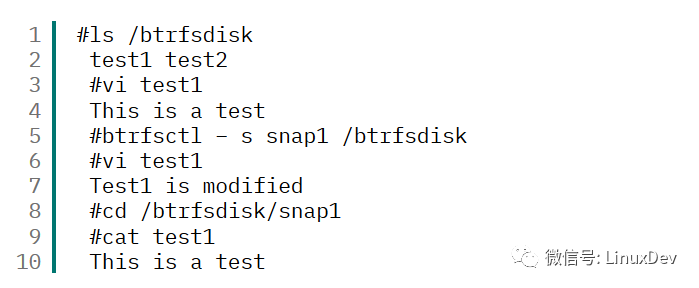
As you can see from the above example, the contents of snapshot snap1 are not changed by subsequent write operations.
Create subvolume
With the btrfs command, users can easily create subvolumes. Assuming /btrfsdisk is mounted to the btrfs file system, users can create new subvolumes within this file system. For example, create a /sub1 subvolume and mount sub1 to /mnt/test:

Subvolme can facilitate administrators to create sub-file systems with different uses on the file system and perform some special configurations. For example, files in some directories are concerned about saving disk space, so you need to turn on compression or configure different RAID strategies. Currently btrfs is still in development stage, and the created subvolme and snapshot cannot be deleted yet. In addition, the disk quota function for subvolume has not been implemented. But as btrfs continues to mature, these features will inevitably be further improved.
Create a RAID
In mkfs, you can specify multiple devices and configure RAID. The following command demonstrates how to use mkfs.btrfs to configure RAID1. Sda6 and sda7 can be configured as RAID1, ie mirror. The user can choose to configure the data as RAID1 or choose to configure the metadata as RAID1.
To configure the data as RAID1, you can use the -d parameter of mkfs.btrfs. As follows:

Adding new equipments
When the space of the device is used up quickly, the user can use the btrfs-vol command to add a new disk device to the file system, thereby increasing storage space. The following command adds a device /sda to the /btrfsdisk file system
The RIMA motive battery is specially designed for frequently deep cycle discharge light electric vehicles, by using the specially designed thicker grid and high density active materials plates, the battery offers reliable performance in high load situations.
Motive Battery are deep cycle batteries, more than 600 cycle lifes at 80% DOD, battery range covers 12V Scooter Battery and Vehicle Batteries.
General Features
Non-spillable
Sealed and Maintenance-free Operation
Computer –added 99.99% pure heavy-duty lead calcium grid design
Exceptional Deep Discharge Recovery
Low Self-discharge
Long Service Life
Solid Copper Terminals
Container formed Plates
Standards:
Compliance with IEC, BS, JIS and EU standards.
UL, CE Certified
ISO45001,ISO 9001 and ISO 14001 certified production facilities
Application
Scooter/E-bike
Golf carts
Floor Machines
Aerial Lifts and Fork Lifts
Marine and RV
Mobility and Medical Equipment
Wheelchair
Electric Vehicles
Motive Battery,Marine Deep Cycle Battery,Deep Cycle Battery Rv,6V Deep Cycle Battery
OREMA POWER CO., LTD. , https://www.oremabattery.com